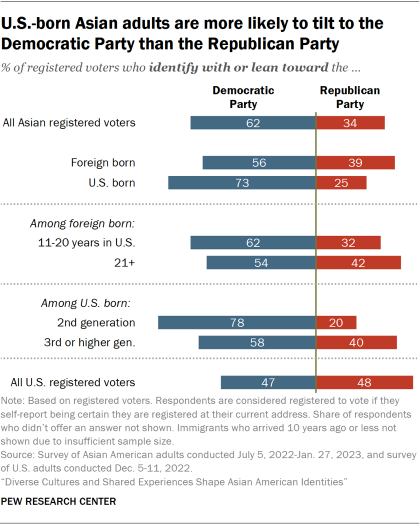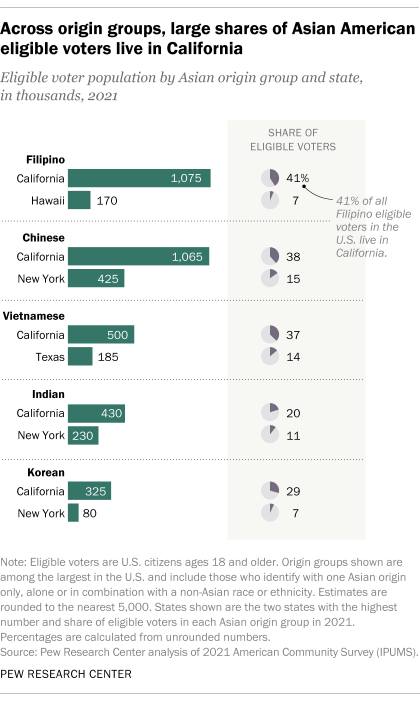About half of Vietnamese American registered voters are Republicans or lean to the GOP – the highest share across the five largest Asian origin groups in the United States.
Overall, about six-in-ten Asian American registered voters (62%) identify as Democrats or lean to the Democratic Party, and 34% are Republicans or GOP leaners, according to a Pew Research Center survey of Asian adults conducted from July 2022 to January 2023.
Around two-thirds of U.S. registered voters who are Filipino (68%), Indian (68%) or Korean (67%) identify as Democrats or lean Democratic. Chinese American voters are also majority Democratic (56%), while Vietnamese American voters tilt to the GOP (51% Republican, 42% Democratic).
Asian voters are more likely than voters overall to affiliate with the Democratic Party: U.S. registered voters are about evenly split between the Democratic Party (47%) and the Republican Party (48%).
Overall, 80% of Asian Americans who are U.S. citizens ages 18 and older (and therefore eligible to vote) report being “absolutely certain” that they are registered to vote at their current address. This includes about three-quarters or more in each of the five origin groups in this analysis.
Pew Research Center conducted this analysis to understand differences in political affiliation among Asian American registered voters, based on their ethnic origin and other demographic factors, as well as examine the geographic distribution of Asian Americans who were eligible to vote in the U.S. in 2021.
Eligible voters are defined as U.S. citizens ages 18 and older. Not all eligible voters are actually registered to vote. Registered voters are defined as those who self-report being certain that they are registered at their current address.
The analysis of Asian American registered voters is based on a nationally representative survey of 7,006 Asian adults. The survey sampled U.S. adults who self-identify as Asian, either alone or in combination with other races or Hispanic ethnicity. It was offered in six languages: Chinese (Simplified and Traditional), English, Hindi, Korean, Tagalog and Vietnamese. Responses were collected from July 5, 2022, to Jan. 27, 2023, by Westat on behalf of Pew Research Center.
The Center recruited a large sample to examine the diversity of the U.S. Asian population, with oversamples of the Chinese, Filipino, Indian, Korean and Vietnamese populations. These are the five largest origin groups among Asian Americans. In this analysis, the five largest ethnic groups include those who identify with one Asian ethnicity only, either alone or in combination with a non-Asian race or ethnicity. Survey respondents were drawn from a national sample of residential mailing addresses, which included addresses from all 50 states and the District of Columbia. Specialized surnames list frames maintained by the Marketing Systems Group were used to supplement the sample. Those eligible to complete the survey were offered the opportunity to do so online or by mail with a paper questionnaire. For more details, read the Methodology. For questions used in this analysis, read the Topline Questionnaire.
The analysis of Asian American eligible voters is based on data from the U.S. Census Bureau’s American Community Survey from 2021 provided through Integrated Public Use Microdata Series (IPUMS) from the University of Minnesota. In this analysis, Asians are defined as those who report their race as Asian alone and non-Hispanic, Asian and at least one other race and non-Hispanic, or Asian and Hispanic. The five largest ethnic groups include those who identify with one Asian ethnicity only, either alone or in combination with a non-Asian race or ethnicity.
Pew Research Center is a subsidiary of The Pew Charitable Trusts, its primary funder. The Center’s Asian American portfolio was funded by The Pew Charitable Trusts, with generous support from The Asian American Foundation; Chan Zuckerberg Initiative DAF, an advised fund of the Silicon Valley Community Foundation; the Robert Wood Johnson Foundation; the Henry Luce Foundation; the Doris Duke Foundation; The Wallace H. Coulter Foundation; The Dirk and Charlene Kabcenell Foundation; The Long Family Foundation; Lu-Hebert Fund; Gee Family Foundation; Joseph Cotchett; the Julian Abdey and Sabrina Moyle Charitable Fund; and Nanci Nishimura.
We would also like to thank the Leaders Forum for its thoughtful leadership and valuable assistance in helping make this survey possible.
The strategic communications campaign used to promote the research was made possible with generous support from the Doris Duke Foundation.
Differences in Asian voter identification by age, gender, education and immigrant status
Among Asian registered voters, majorities across most demographic groups favor the Democratic Party, but there are some differences by age, gender and other factors:

- Younger Asian registered voters are far more likely than older ones to tilt Democratic. Among all Asian Americans who are registered to vote, 88% of those under 30 identify with or lean to the Democratic Party, compared with 67% of those ages 30 to 49, 51% of those 50 to 64 and 48% of those 65 and older. Just 11% of Asian registered voters under 30 are Republicans or lean to the GOP, compared with larger shares in older age groups. Among Asians 65 and older, for instance, 43% are Republicans or Republican leaning.
- Among Asian registered voters, women are more Democratic than men. About two-thirds of Asian women who are registered voters are Democrats or lean to the Democratic Party (67%), compared with 56% of Asian men.
- Asian registered voters with a lower level of education are somewhat more likely to support the GOP. For instance, 45% of those with a high school diploma or less education are Republicans or lean Republican, compared with 30% of Asian voters with a bachelor’s degree and 27% of those with a postgraduate degree.

- Asian registered voters born in the U.S. are more likely than those who immigrated to the country to affiliate with the Democratic Party. About three-quarters of those born in the U.S. are Democrats or lean Democratic (73%), compared with 56% of foreign-born Asian registered voters. A quarter of U.S.-born Asians are Republicans or lean to the GOP, as are 39% of those who are foreign born.
- About four-in-ten foreign-born Asian registered voters who have lived in the country for more than 20 years identify as Republican or lean to the GOP (42%). This compares with about a third (32%) of those who have spent 11 to 20 years in the U.S.
Where Asian eligible voters live
Asian Americans represent a relatively small but fast-growing segment of the U.S. electorate. In 2021, 13.4 million Asian Americans were eligible to vote, making up 5.6% of all eligible voters, according to a Pew Research Center analysis of the 2021 American Community Survey. Eligible voters in this analysis are defined as U.S. citizens ages 18 and older who live in the 50 states and the District of Columbia. Not all eligible voters are registered to vote.
In 2021, the 2.8 million Chinese American eligible voters in the U.S. accounted for the largest population of any Asian origin group, followed by Filipino (2.6 million), Indian (2.1 million), Vietnamese (1.3 million) and Korean American (1.1 million) eligible voters.

As of 2021, the majority of Asian American eligible voters (56%) live in just five states. The state with the highest share is California, which is home to 4.3 million Asian eligible voters – accounting for about a third (32%) of the total Asian eligible voter population. The state with the second-largest share of Asian American eligible voters is New York (1.1 million), followed by Texas (960,000), Hawaii (575,000) and New Jersey (545,000).
Among each of the country’s five most populous Asian origin groups, California also has the highest share of eligible voters of each group. This includes about four-in-ten eligible voters who are Filipino (41%), Chinese (38%) or Vietnamese (37%). Three-in-ten Korean eligible voters (29%) and one-fifth of Indian eligible voters (20%) live in California as well. The state with the second-largest share of eligible voters among each origin group varies. Some 14% of Vietnamese eligible voters live in Texas, and 7% of Filipino eligible voters live in Hawaii. New York is home to 15% of Chinese, 11% of Indian and 7% of Korean eligible voters.



